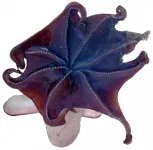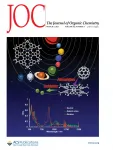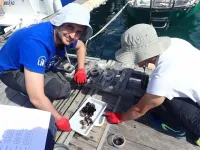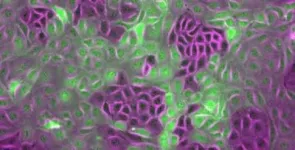First description of a new octopus species without using a scalpel
Biologists at the University of Bonn use state-of-the-art non-destructive methods to study an octopus from the deep sea
2021-04-23
(Press-News.org) An evolutionary biologist from the University of Bonn brought a new octopus species to light from depths of more than 4,000 meters in the North Pacific Ocean. The sensational discovery made waves in the media a few years ago. Researchers in Bonn have now published the species description and named the animal "Emperor dumbo" (Grimpoteuthis imperator). Just as unusual as the organism is the researchers' approach: in order to describe the new species, they did not dissect the rare creature, but instead used non-destructive imaging techniques. The results have now been published in the prestigious journal BMC Biology.
In the summer of 2016, Dr. Alexander Ziegler from the Institute of Evolutionary Biology and Ecology at the University of Bonn spent several months in the North Pacific aboard the research vessel SONNE. The crew lowered the steel basket to the seabed around 150 times in order to retrieve rocks, sediments, and living creatures. One organism in particular caused a media stir: a dumbo octopus. The animal, about 30 centimeters in size, was found in waters more than 4,000 meters deep. However, the octopus could not be recovered alive: "The deep-sea organism is not adapted to the environmental conditions of the ocean surface," Ziegler explains.
Dumbo octopuses are a group of deep-sea-dwelling octopuses that includes 45 species. The name is based on the flying elephant from the Walt Disney movie of the same name, who is made fun of because of his unusually large ears - the fins of the dumbo octopuses, which are on the sides of the head resemble these elephant ears. However, the dumbo on the research vessel SONNE differed significantly from the known octopus species. "It was clear to me straight away that we had caught something very special," the biologist reports. So Ziegler immediately photographed the unusual animal, took a small tissue sample for DNA analysis, and then preserved the octopus in formalin.
Together with his former master's student Christina Sagorny, Ziegler has now published a description of the previously unknown species. Just as unusual as the octopus was the methodology used. The animals are usually dissected by zoologists, as the internal organs are also important for the description of a new species. "However, as this octopus is very valuable, we were looking for a non-destructive method," explains the researcher.
High-field MRI instead of scalpel
The eight-armed cephalopod therefore did not end up under the scalpel, but in the high-field magnetic resonance imaging system of the German Center for Neurodegenerative Diseases (DZNE) in Bonn. This device is routinely used to image test persons' brains. Thankfully, Dr. Eberhard D. Pracht from the DZNE agreed to conduct a high-resolution scan of the dumbo octopus in 3D. As part of her master's thesis, Christina Sagorny then investigated whether high-field MRI can be used to study internal organs and other soft tissues just as well as through conventional dissection. "The quality is actually even better," Ziegler says.
One of the few exceptions: the beak and rasping tongue (radula) of the cephalopod are made of hard chitin that does not image well using MRI. The biologists therefore also consulted the micro-computed tomography system of the paleontologists at the University of Bonn. This technique showed the beak and radula razor-sharp and in 3D. "These hard part structures are an integral part of the species description of octopuses," Ziegler explains. The researchers also decoded the animal's genetic material to reconstruct the family relationships. Ziegler: "The DNA showed beyond a doubt that we were looking at a species of the genus Grimpoteuthis."
Examination of the reproductive organs revealed the dumbo octopus to be an adult male. Compared to other species of this genus, it displays several special characteristics. For example, an average of 71 suckers were detected on each arm, which the animal needs to catch prey and which reflect body size. The length of the cirri, which are small appendages on the arms that the deep-sea animals presumably use to sense their prey, also differs from species already known.
The web that stretches between the arms, with which the dumbo slowly floats down in the water column, catching worms and crustaceans as if in a bell, also only reaches just over halfway from the mouth down the arms. "The web is much longer in dumbo octopus species that mainly float freely in the water column," Ziegler says. This would indicate that the new species lives close to the seafloor, because otherwise the web would be a hindrance to movements on the bottom.
As the species-describing researchers, Sagorny and Ziegler had the privilege of naming the new species: they decided on Grimpoteuthis imperator - in English "Emperor dumbo". Background: the animal was discovered not far from Japan in an underwater mountain range whose peaks are named after Japanese emperors.
Digital copy of the organism
The combination of non-destructive methods produced a crisp digital copy of the animal. Anybody interested can download it from the online database "MorphoBank" for further research and learning purposes. The preserved octopus itself is kept in the archives of the Museum für Naturkunde in Berlin, Germany. "There, it can then still be analyzed 100 years from now, for example when more modern investigation methods or new questions arise," Ziegler explains. "Our non-destructive approach could set a precedent, especially for rare and valuable animals," said the Bonn-based evolutionary biologist.
INFORMATION:
Funding:
No third-party funds were used to conduct the study.
Publication: Alexander Ziegler, Christina Sagorny: Holistic description of new deep sea megafauna (Cephalopoda: Cirrata) using a minimally invasive approach, BMC Biology, DOI: https://doi.org/10.1186/s12915-021-01000-9
Video of the recovery of the emperor dumbo: https://bmcbiol.biomedcentral.com/articles/10.1186/s12915-021-01000-9
Media contact:
Priv.-Doz. Dr. Alexander Ziegler
Institute of Evolutionary Biology and Ecology
University of Bonn
E-mail: aziegler@evolution.uni-bonn.de
[Attachments] See images for this press release:

ELSE PRESS RELEASES FROM THIS DATE:
2021-04-23
A continental-scale network of conservation sites is likely to remain effective under future climate change scenarios, despite a predicted shift in key species distributions.
New research, led by Durham University and published in the journal Frontiers in Ecology and Evolution, investigates the impacts of potential climate change scenarios on the network of Important Bird and Biodiversity Areas (IBAs) across the Caribbean, and Central and South America.
The research was carried out in collaboration with Senckenberg Biodiversity and Climate Research Centre, BirdLife International and the National Audubon Society.
IBAs are sites identified as being internationally important for the conservation of bird populations, with over 13,000 ...
2021-04-23
There are many different types of cancer, but they all have one thing in common: errors in the signals that control normal cell behaviour can cause uncontrolled cell growth and cell division, leading to a tumour. An enzyme called SHP2 plays a key role in this regard. SHP2 is a signalling molecule that in its activated state stimulates cell proliferation. In a normal healthy body, the rates of cell proliferation and cell death are balanced and tumours do not develop. However, if SHP2 becomes too active, the number of cells being created outweighs the number that die, which can lead to the formation of dangerous tumours. Enhanced SHP2 activity resulting from genetic ...
2021-04-23
Researchers at the University of Cincinnati say a regulatory protein found in skeletal muscle fiber may play an important role in the body's fight or flight response when encountering stressful situations.
The protein, fast skeletal myosin binding protein-C (fMyBP-C), plays a foundational role in the proper regulation of contractile structure and function in the body's fast twitch muscles -- these muscles produce sudden bursts of power to sprint into action, jump or lift heavy objects. Fast skeletal myosin binding protein-C modulates the speed and force of fast skeletal muscle contraction.
"This response ...
2021-04-23
People with type 2 diabetes tend to have poorer muscle function than others. Now a research team at Lund University in Sweden has discovered that in type 2 diabetes, a specific gene is of great importance for the ability of muscle stem cells to create new mature muscle cells. The findings are published in Nature Communications.
"In people with type 2 diabetes, the VPS39 gene is significantly less active in the muscle cells than it is in other people, and the stem cells with less activity of the gene do not form new muscle cells to the same degree. The gene is important when muscle cells absorb sugar from blood and build new muscle. Our study is the first ever to link this gene to type 2 diabetes", says Charlotte Ling, professor of epigenetics at Lund University who led ...
2021-04-23
Recently study on synthetic approaches toward polycyclic aromatic hydrocarbons (PAHs) as graphene with a well-defined structure has attracted much attention. A research group in Ehime University has been studying the synthesis and fundamental properties of pyrrole-fused azacoronene (HPHAC), a nitrogen-containing PAH. HPHACs are composed of electron-rich pyrroles, which are easily oxidized, and their dicationic species in particular exhibit unique features such as global aromaticity based on macrocyclic π-conjugation. However, all the compounds reported so far have bulky ...
2021-04-23
An interdisciplinary group of Spanish scientists, bringing together biologists and chemists from the Universities of Seville, Huelva, the Autonomous University of Madrid and the Institute of Marine Sciences of Andalusia of the CSIC in Cadiz, have just published the results of their pioneering research studying the management of marinas. The group of scientists, led by the US professor José Manuel Guerra García, studied in detail the sediments in Andalusia's marinas and has proposed a new index, the MEPI (Marinas Environmental Pollution Index) to quantify the level of contamination in these ports.
There has been a proliferation of marinas in recent ...
2021-04-23
The giant star featured in this latest Hubble Space Telescope anniversary image is waging a tug-of-war between gravity and radiation to avoid self-destruction. The star, called AG Carinae, is surrounded by an expanding shell of gas and dust -- a nebula -- that is shaped by the powerful winds of the star. The nebula is about five light-years wide, which equals the distance from here to our nearest star, Alpha Centauri.
The huge structure was created from one or more giant eruptions several thousand years ago. The star's outer layers were blown into space, the expelled material ...
2021-04-23
How do the billions of cells communicate in order to perform tasks? The cells exert force on their environment through movement - and in doing so, they communicate. They work as a group in order to infiltrate their environment, perform wound healing and the like. They sense the stiffness or softness of their surroundings and this helps them connect and organize their collective effort. But when the connection between cells is distrubeddisturbed, a situation just like when cancer is initiated, can appear.
Assistant Professor Amin Doostmohammadi at the Niels Bohr Institute, University of Copenhagen has investigated the mechanics of cell movement and connection ...
2021-04-23
Etrasimod 2 mg treatment group achieved statistical significance in the percentage change in weekly peak pruritis (PP-NRS), in the change in Dermatology Life Quality Index (DLQI), and in the change in Patient-Oriented Eczema Measure (POEM)
Etrasimod 2 mg was generally well tolerated, consistent with data in previous trials
Park City, Utah, April 23, 2021 - Arena Pharmaceuticals, Inc. (Nasdaq: ARNA) today announced data at a late-breaking session at the American Academy of Dermatology VMX Experience. Etrasimod, a novel investigational drug candidate to treat moderate-to-severe atopic dermatitis (AD), demonstrated statistical significance in both clinician and patient reported outcomes in the ADVISE Phase 2b clinical trial. Etrasimod is a highly selective, once-daily, oral sphingosine ...
2021-04-23
Paper Title: Safety of Tranexamic Acid in Hip and Knee Arthroplasty in High-risk Patients
Journal: Anesthesiology
Authors: Jashvant Poeran MD, PhD, Director of the Center for Clinical and Outcomes Research, and Associate Professor of Population Health Science & Policy and Orthopedics at the Icahn School of Medicine at Mount Sinai; Calin S. Moucha, MD, Chief of Adult Reconstruction & Joint Replacement Surgery at Mount Sinai Hospital, and Associate Professor of Orthopedics at the Icahn School of Medicine at Mount Sinai; and other coauthors.
Bottom Line: The use of the drug tranexamic acid is commonplace in patients undergoing hip or knee replacement surgery to reduce blood loss. However, this drug works by promoting clotting and safety concerns exist when used in certain high-risk ...
LAST 30 PRESS RELEASES:
[Press-News.org] First description of a new octopus species without using a scalpel
Biologists at the University of Bonn use state-of-the-art non-destructive methods to study an octopus from the deep sea







